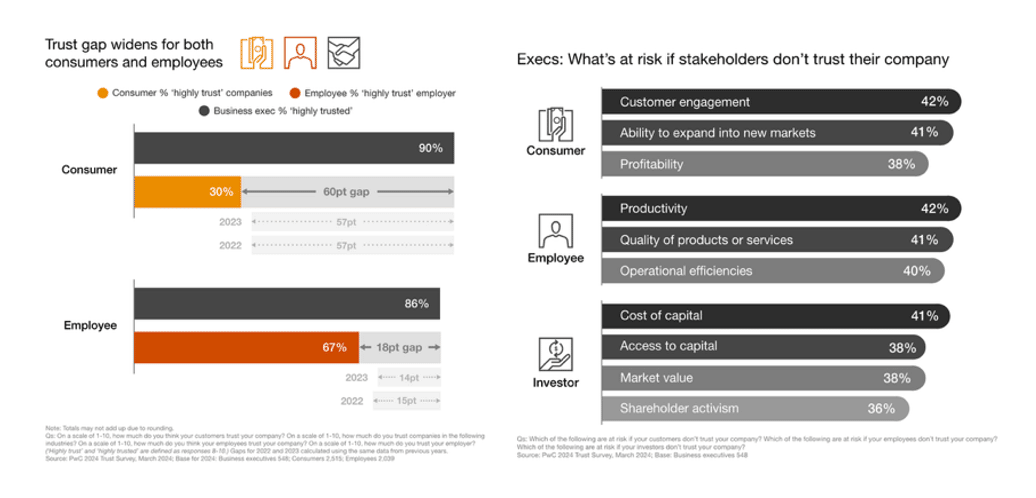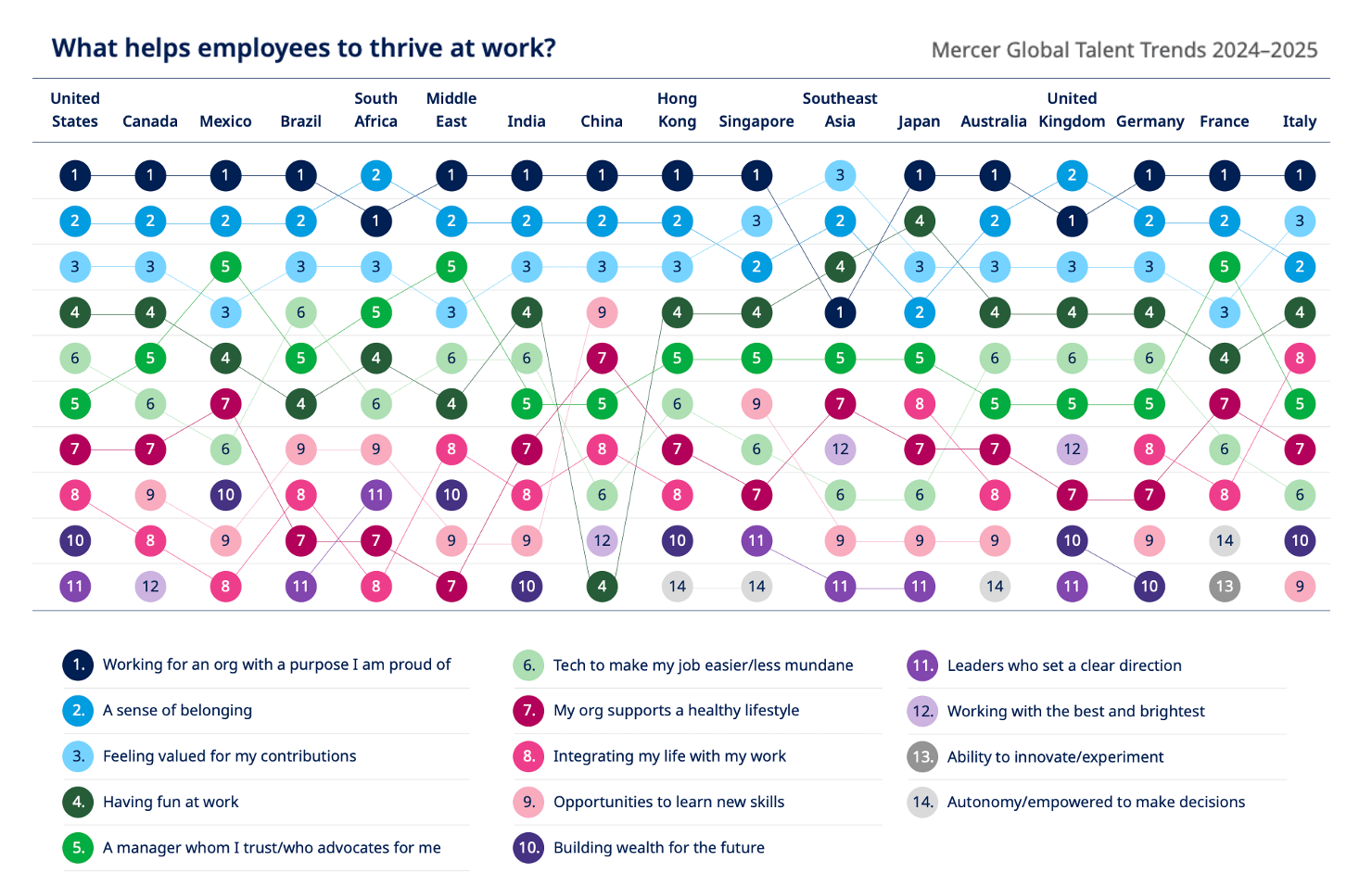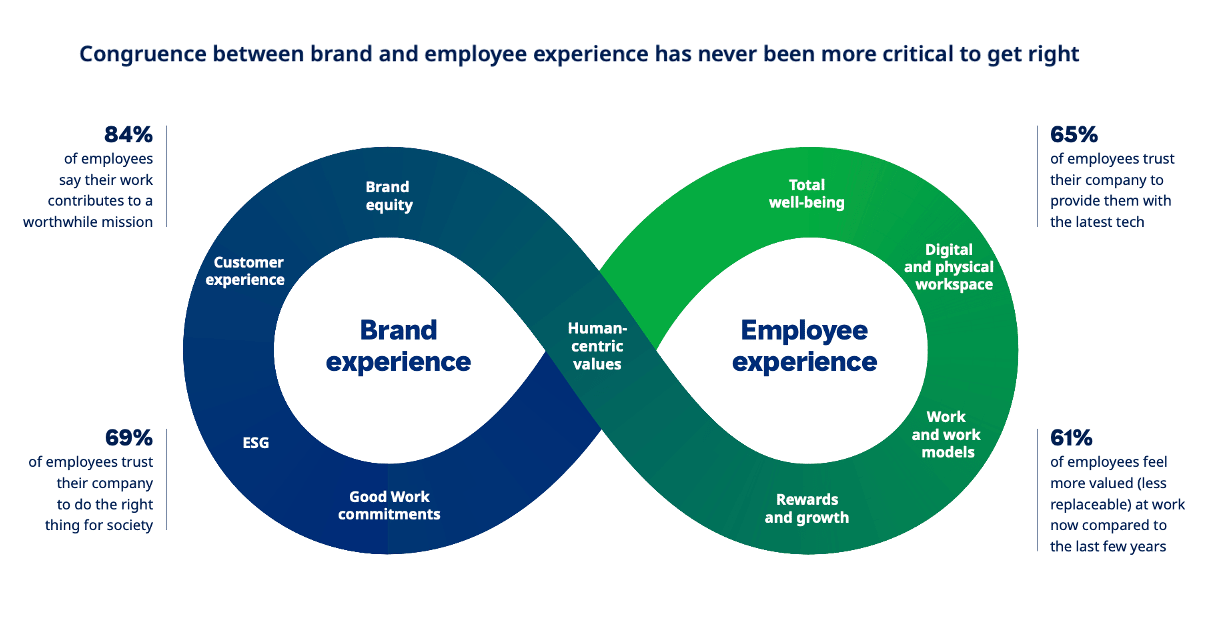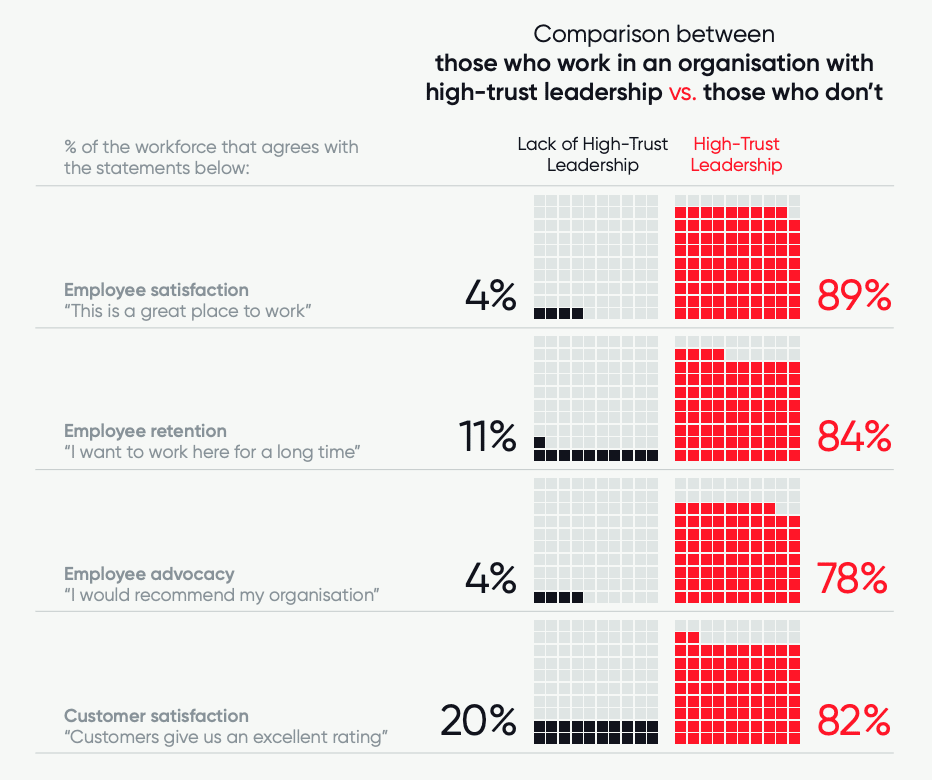Build Trust. Multiply Results.

Trust has declined, globally. Meantime, market conditions are challenging, changing, and more complex. Your teams need to work together better, faster, and smarter for your business to compete. Trust is a must.
“You can’t build a digitally connected organization without building human trust at its core.” — Satya Nadella, CEO, Microsoft
Trust is Transformational
Trust is a big deal. Trust is a critical building block of a solid company foundation. Trust weaves the fabric of anchoring values that found a strong culture. Trust connects a working community nurturing a sense of belonging and psychological safety.
Trust is transformational for cultivating a grounded, engaged, and high-performing distributed workforce who are ready to respond quickly to customer demands and keep adapting to changing conditions.
Yet, trust in all institutions, including employers, has declined globally:

- 68% of employees believe business leaders purposefully say false or grossly exaggerated things, up 12 pts from 2021, a record high [2025 Edelman Trust Barometer].
LOW TRUST: Bottlenecks & Breaks
Weak trust decreases the probability customers buy from you, reduces employee engagement, decreases productive debate and informed decision-making, all undermining your business results. Executives miss key trust gaps:
- Highly trusted company? 90% of execs believe vs 30% of customers.
- Highly trusted employer? 86% of execs believe vs 67% of employees.
- 40% of customers stop purchasing from a company they don't trust.
- 61% of employees say perceived lack of trust by company leadership impacts their ability to do their jobs well.
- 42% of execs say productivity is at risk if employees don't trust the firm.

- 73% of employees say lack of trust is top driver of workplace conflict Result: 53% feel stressed, 45% report sick/absent, 77% disengaged [Workplace Peace Institute, State of Conflict in the Workplace].
“Employees’ trust in their organization is the strongest variable influencing how energised they feel at work, their sense of thriving and their intent to stay.” — [Mercer, 2024-2025 Global Talent Trends]
HIGH TRUST: Boosters & Benefits
The upsides of sustained cultivation of trust are multifold and significant:
- Customers - 46% purchased more, 28% paid a premium.
- Employees - 260% more motivated, 41% less absenteeism, 50% less likely to seek another job.
- Profitability - 93% of execs agree building/maintaining trust improves the bottom line [PwC 2024 Trust Survey].
- Productivity - dramatically increases [The Productivity Institute, i4cp].

High trust company employees: 106% more energy, 76% more engaged, 50% more productive, enjoyed their jobs 60% more, 66% closer to coworkers, 70% more aligned with company purpose, and experienced 40% less burnout than respondents in the low trust quartile [Paul J. Zak, Neuroscience of Trust, HBR].
Thriving Through Trust
Three of the top five factors that help employees thrive relate to trust – #2 belonging, #3 feeling valued, and #3 having a manager who trusts and advocates for them:

Employees emphasise what is most important for them to build trust:
- 77% say fair pay and fair treatment are very important.
- 72% say protecting employee data and ethical behavior matter.
- 72% cite remote/hybrid policies.
- 71% say flexibility around when work gets done.
- 68% say strengthening relationships by listening.
- 61% say opportunities for career advancement.
- 89% say data privacy policies should be disclosed [PwC Trust Survey].
“Organizations move at the speed of trust.” — Stephen M.R. Covey, author of The Speed of Trust, Trust & Inspire.
Consistent & Congruent
The benefits of trust are a no brainer. Why then is trust low and declining? Showing and sustaining trust necessarily involves ceding some control, empowering and believing in others with whom relationships may be weak or strained.
>> 74% of execs believe most of their workers cannot adapt to the new world of work [Mercer]. How can you help your teams learn and adapt so your business can grow?
Trust must be pervasive not patchy, thorough not targeted or transient. Employees react negatively to inconsistent or one-sided corporate values – such as trusting office-based workers more:
> ‘Only’ 20% of executives say they trust in-person employees more than hybrid/remote employees, while 31% of employees think leaders trust in-person employees more [PwC]. Have you transitioned yet to results-based metrics to reduce focus on presence over performance?
Prospects and customers will not trust you if your workforce doesn’t. Review the strength of trust across your Customer Journey and Employee Journey which together comprise the human-centric system of your business [see my book Empathy Works]. The Brand and Employee Experiences are close equivalents, depicted here mutually reinforcing (or undermining) trust [Mercer]:

Internally, C-suite members MUST trust each other so trust is felt throughout the organization, fostering a culture of openness and collaboration, but:
- 44% of C-suite peers trust each other vs 53% of non-C-suite peers.
- Only 32% of employees say they trust entry-level employees to 'a great extent' [PwC].
Trust Busts & Blockers
Trust is learned and earned. Trust busted takes time to rebuild. Pay attention to areas which risk pitfalls and misunderstandings:
- Overloaded: Unearned trust or blind trust leads to error/betrayal.
- Fragmented: Subgroups trust internally but distrust across units.
- Misplaced: Leaders must calibrate trust, both ability and integrity.
- Unmaintained: Trust erodes silently if not tended to.
- Unbalanced: Distributed architecture--such as zero trust must recognise relational dynamics and support trust or collaboration is impacted [Cornell arXiv Rethinking trust in the digital age].
How can you start cultivating trust to transform your business results?
Digital DNA

Human-centric workforce innovation in the age of AI
workforce and scale your business, navigating the fast-paced
unpredictable marketplace.
Generational EQ

Distributed Works

CLICK TO VOTE!
Even teams performing well hit friction.
As work evolves fast and unevenly, alignment, motivation, connection and trust are hard to develop and sustain. We’re curious—what’s most top-of-mind for you right now?
I’ll share what other leaders are saying next week—so you can see how your peers are navigating these same shifts.
Why This Matters: These challenges reflect deeper changes in how we work. Today’s leaders need to integrate empathy with intention to foster trust, increase engagement, reduce conflict and improve performance. Leading effectively now means listening differently, learning continuously, and rethinking how teams connect and co-create.
That’s the foundation of my self-paced Empowering High-Performing Teams course. It’s designed to help you:
- Build trust and clarity across teams and locations
- Create psychological safety that drives innovation
- Empower people to perform sustainably—not burn out
High performance isn’t about pushing harder. It’s about learning, leading, and adapting—together.
Scaling Skills-first

Building the Basics
Trust is shown, earned, built over time, AND needs to be actively maintained:
- Approach as a team. Treat trust as a collective responsibility and its effects on customer engagement, market expansion opportunities, engagement, productivity, and profitability.
- Nurture the culture: Start by fostering trust within the C-suite. This foundation at the top is critical to model for leaders at all levels.
- Ask for help: Leaders stimulate oxytocin in their teams by seeking inputs which shows respect and develops trust.
- Measure formally: Use a common set of metrics gathered in periodic trust audits or pulse surveys with “trust markers” such as meeting behavior, responsiveness norms.
- Act promptly: Ensure prompt follow-up on issues todefine and repair broken trust in explicit conversations and restoration plans.
- Cross boundaries: Create options to bridge hierarchy, silo, and age gaps with shadowing, rotating roles and diverse project assignments.
- Unify messaging: Align narratives consistently without conflicting messages to avoid confusion, communicating transparently and engaging stakeholders intentionally.
- Embed from inception. With technology implementations and regulation, design for trust with transparency core to reporting strategies with appropriate controls and processes.
- Infuse onboarding: Develop rituals for new teams to establish trusting norms and expectations to encourage ‘swift trust’ monitoring pre-agreed behaviours to anchor initial efforts.
"Trust is the currency of the digital era. Without it, everything slows down.” — Rachel Botsman, author of Who Can You Trust?
- Run a trust inventory — List all points where trust is tested such as task handoffs, remote synchronisation, and decision handovers.
- Score trust points: Grade current status (1-5) for effective data sharing, clarity of communication, and feedback loops.
- Deploy an intervention: For 2–3 weakest trust points, deploy a small intervention such as “ask for dissent,” run a micro-retrospective, have leaders share a vulnerability.
- Host a conversation: What key factors would help team members feel safe? Where is trust broken and how can we start to repair it?
- Add dashboard metrics: Identify measurements to include on your health dashboard with pulse questions similar to “I trust my colleagues" and "leadership to act in good faith.”
- Commit to a ritual: Co-create trust-building rituals with managers and team contributing such as weekly recognition and cross-team sharing.
Trusting -> Trust in Leadership
Leadership must set the example, demonstrate trust consistently, and nurture reciprocal relationships:

“In the absence of trust, people withhold themselves—their ideas, their energy, their passion.” — Patrick Lencioni, author of The Five Dysfunctions of a Team.
Human-centric Leadership Audit

News & Muse

📘 The Speed of Trust, Stephen Covey - a compelling exploration of trust and its impact.
🗞️ How to Build a High Trust Workplace, MIT Sloan - useful steps to get started on right away.
📹 The Currency of the New Economy is Trust, Rachel Botsman - worth watching to reinforce trust's relevance.
🎶 Count on Me, Bruno Mars - supportive, energising, and a great lilting song!
Yes, trust matters. Trust is closely related to empathy. Oxytocin reduces negative reactions including anxiety and stressors in social situations. Oxytocin increases a person’s ability to empathise and reduces their fear of trusting someone. Trust and empathy are core to human-centric leadership which counterbalances the technology drivers of modern work.
Leaders who thrive in this new era are those who build trust and relationships, who share information and responsibility. Greater cohesion, collaboration, and collective intelligence become the competitive edge.
That's it for this week's mega session on trust!
Until next time.
Sophie
Scalable strategies. Tactical talk. Workforce transformation.
Human-centric workforce innovation in the age of AI
workforce and scale your business, navigating the fast-paced
unpredictable marketplace.
